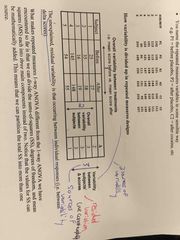![]()
![]()
![]()
Use LEFT and RIGHT arrow keys to navigate between flashcards;
Use UP and DOWN arrow keys to flip the card;
H to show hint;
A reads text to speech;
20 Cards in this Set
- Front
- Back
- 3rd side (hint)
|
Stats Flowchart |
Hypothesis Chose the needed comparisons Decide if parametric tests are needed Transform the data to fit parametric tests |
|
|
|
Repeated Measures |
Each subject is measured more than once They can serve as their own control |
|
|
|
Simplest Within Design |
One group of subjects each individual measured twice at different times Assess with a paired t-test |
|
|
|
Sources of variability in Repeated Measures |
Variability between treatments Variability between delta scores (residual variability) |

|
|
|
Variation in traditional ANOVA |
SStotal composed of SSbetween (treatment) and SS within |
|
|
|
Variation in Repeated Measures |
SS total is comprised of SS treatment and SS residual NO BETWEEN SUBJECTS VARIATION F = MStreat/MSresidual MS is assumption of population variance |
|
|
|
Why Repeated Measures is Better |
Make MS residual smaller by reducing variation between subjects |
|
|
|
Reminder About Error Bars |
Don't tell us much in a repeated measures design Delta could be increased consistently each time |
|
|
|
Degrees of Freedom in 1 way ANOVA |
a= # of groups Classic: (a-1), a(n-1) Repeated Measures: (a-1), (a-1)(n-1) - UNIVARIATE |
|
|
|
Univariate and Multivariate Agree |
They are both significant Report univariate Report either Greenhouse-Geisser (more conservative) Huynh-Feldt (more liberal) Which you report depends on design |
|
|
|
Uni and Multi Disagree |
One is significant and the other is not You may have violated assumptions Best to report the multivariate if they slightly disagree Or consult statistician if they really dont agree |
|
|
|
Why repeated measures is alpha |
You can greatly reduce residual error |
|
|
|
2 Way Between DFs |
Factor A: (a-1) Factor B: (b-1) AxB: (a-1)(b-1) Residual: ab(n-1) |
|
|
|
2 Way Within DFs |
A: (a-1) resid: (a-1)(n-1) B : (b-1) resid: (b-1)(n-1) AxB: (a-1)(b-1) resid: (a-1)(b-1)(n-1) |
|
|
|
ANOVAs on Percentages |
Each condition needs replicates Parametric assumptions must be met Beware of skewness near 0 and 100 |
|
|
|
When to NOT do ANOVA on percentage |
When there is no within cell variability Instead: Chi-Square or Fischer exact test |
|
|
|
MCTs and Repeated ANOVA |
Dunnetts - MSerror greatly reduced, becomes super powerful Tukeys- Super powerful as well (First two cannot be performed by most stats programs) Bonferroni- with laired t tests easiest with stats as long as comparisons arent over 8 |
|
|
|
MCTs and Normalization |
Raw Data: Repeated measures and any MCT Final group mean and SEM multiplied by 100/MEAN: Can do all tests, will provide same p as variation between and within are multiplied by a constant Each raw value multiplied by 100/control value: No variance in control group Cannot perform ANOVA or MCTs Can still do paired t with bonferroni
|
|
|
|
Simpsons Paradox |

Direction of a correlation can be reversed by a lurking variable Success rates for one treatment can be better in both cases but reversed when the cases are combined |
|
|
|
Defining the Variability |
Between Subjects - Different folks not used in repeated measures Between Treatment - Variation because of the treatment Residual - How an individual responds to a given tretment |
|

